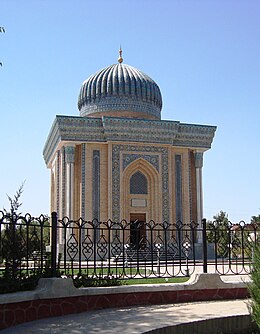Badr al-Din al-Ayni
Badr al-Din al-'Ayni | |
|---|---|
| Personal | |
| Born | 30 July 1361 Maturidi[1] |
Abū Muḥammad Maḥmūd ibn Aḥmad ibn Mūsā Badr al-Dīn al-ʿAynī, often quoted simply as al-'Ayni (
Biography
He was born into a scholarly family in 762
He established a good reputation and initially met with favor. However, after al-Sayrāmī died in 790 AH (1388 CE), al-'Ayni became involved in a personal conflict with the
From Cairo he went to teach in
Once back in Cairo, al-'Ayni strengthened his social and political position by associating with several amirs, making the
Al-'Ayni and al-Maqrīzī succeeded each other as muhtasib of Cairo several times over the next few years, probably a reflection of the power struggle between Jakm min 'Awd and al-Maqrīzī's patron, Yashbak al-Sha'bānī.
| Part of a series on |
| Maturidism |
|---|
 |
| Background |
|
Al-'Ayni's prestige grew as he aged. Mu'ayyad Shaykh named him ambassador to the
Barsbāy often turned to al-'Ayni for advice on legal matters,
In the reign of Barsbāy's successor, al-Aziz Jaqmaq, al-'Ayni was dismissed as chief Hanafi qadi again. He withdrew from court and concentrated on his scholarly writing.[30] In 853 AH (1449 CE) he was dismissed as nāzir al-ahbas, probably because of failing memory.[31] He died in 855 AH (1451 CE) at the age of ninety-three, having outlived all his children, and was buried in his own madrasah in Cairo.
Works
- Umdat al-Qari[5]
- al-Binaya Sharh al-Hidaya
- al-Sayf al-Muhammad fī Sīrat al-Malik al-Mu'ayyad (a biography of the sultan Mu'ayyad Shaykh)
- 'Iqd al-Jūman fī Ta'rikh Ahl al-Zamán, translated to French as "Le collier des perles" ("The Pearl Necklace")
- ar-Rad al-Waafir (Arabic: الرد الوافر)
- Nukhab al-Afkar fi Tahqiq Mabani al-Akhbar fi Sharh Ma`ani al-Aathar
- Sharh Sunan Abu daud - published in Pakistan
See also
- List of Islamic scholars
- List of Hanafis
- List of Ash'aris and Maturidis
References
- ^ محمد ياسين بن محمد عيسى الفاداني المكي (2005). "الروض الفائح وبغية الغادي والرائح بإجازة فضيلة الأستاذ محمد رياض المالح" (in Arabic). Beirut: Dar al-Basha'ir al-Islamiyya. p. 27.
الآثار المخطوطة: ۱ ـ رسالة التوحيد على مذهب الإمام أبي منصور الماتريدي، للإمام بدر الدين العيني
- ISBN 978-1851686636.
- ISBN 9004081143.
- ^ "Int". www.e-imj.com. Archived from the original on 10 October 2006. Retrieved 15 January 2022.
- ^ a b Abdal-Hakim Murad – Contentions 8
- ^ "Beards: Ibn Abidin says". qibla.com. 14 September 2012.
- ISBN 9780190092924.
- ^ Al-'Ayni, al-Sayf al-Muhammad fī Sīrat al-Malik al-Mu'ayyad, ed. Falūm Muhammad Shaltūt (Cairo, 1967.)
- ISBN 9781400856411. Retrieved 5 January 2023.
- ^ Anne F. Broadbridge, "Academic Rivalry and the Patronage System in Fifteenth-Century Egypt", Mamluk Studies Review,Vol. 3 (1999), Note 4.
- ^ Ibn Taghrībirdī, al-Nujūm al-Zāhirah fī Mulūk Misr wa-al-Qahirah (Beirut, 1992.)
- ^ Broadbridge, p.87.
- '^ Al-Sākhawī, al Daw' al-Lami' li-Ahl al-Qarn al-Tasi (Cairo, date not given.)
- ^ Ibn Taghrībirdī, quoting al-'Ayni in al-Nujūm al-Zāhirah fī Mulūk Misr wa-al-Qahirah (Beirut, 1992), 4:207.
- ^ Al-'Ayni, al-Sayf al-Muhammad, editor's introduction, p. li.
- ^ Al-'Ayni, 'Iqd al-Jumān fī Ta'rikh Ahl al-Zamán, ed. 'Abd al-Rāziq al-Tanrāwi al-Qarmūt (Cairo, 1985.)
- ^ Ibn Taghrībirdī, al-Manhal al-Sāfi al-Muhammad fī Sirat al-Malik al-Mu'ayyad, ed. Muhammad Muhammad Amin (Cairo, 1984), 1:417.
- ^ Ibn Taghrībirdī, al-Manhal al-Sāfi, 4:313–22.
- ^ al-Maqrīzī, Kitāb al-Sulúk li-Ma'rifat Duwal al-Mulúk, ed. Sa'id Āshūr (Cairo, 1973), 3:2:740.
- ^ a b Ibn Taghribīrdī, al-Nujūm, 15:287.
- ^ Broadbridge, pp.89–90, "The Muhtasib Incident".
- ^ Broadbridge, p.91.
- ^ Ibn Taghribīrdī, History of Egypt 1382–1467, trans. William Popper, University of California (Berkeley, 1958.)
- ^ Al-Maqrīzī, Kitāb al-Sulūk, 4:2:698.
- ^ Al-Sakhāwi, "al-I'lān bi-al-Tawdīh li Man Damma Ahl al-Tārikh," edited and translated by Franz Rosenthal in A History of Muslim Historiography (Leiden, 1952.)
- ^ Ibn Taghribīrdī, al-Nujūm, 15:287; trans. Broadbridge, p. 96.
- ^ a b Al-'Ayni, 'Iqd al-Jumān, 2:21.
- ^ al-Sakhawi, al-Daw' , 10:134.
- ^ Al-'Ayni, 'Iqd al-Jumān, 372.
- ^ al-Sakhāwi, al-Daw' , 10:133.
- ^ Ibn Taghribīrdī, History of Egypt 1382–1467, trans. Popper, 19:118.
